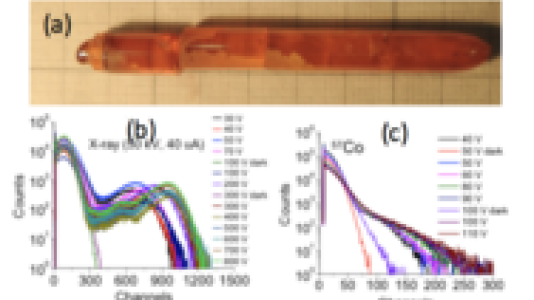
Semiconducting perovskite metal halides exhibit excellent performance in optics and photonics with high carrier mobility, long carrier lifetime, defect tolerance, strong optical absorption, and high photoluminescence quantum efficiencies. As a promising candidate in the area of hard radiation detection, the orange colored compound CsPbBr3 possessing high density (4.85 g/cm3) and direct band gap (2.25 eV) has attenuation coefficient comparable to Cd1-xZnxTe (CZT) which is a leading semiconductor in radiation detection. Additionally, previous reports on CsPbBr3 show high resistivity (r) ~109 W∙cm, high mobility (m) and lifetime (t) in the range of 1,000 - 4,500 cm2/Vs and 2.5 - 9.2 μs, respectively, depending on bulk form or nanocrystals, by which CsPbBr3 well meets the requirements for good X- and g-ray detector candidate materials.
Several studies on CsPbBr3 to improve the quality of material as well as to tune the compositions and physical forms, bulk, nanoparticles, and thin film, have recently been reported. Developing chemical processes to grow high quality crystals is crucial because impurities and defects adversely affect the carrier mobility, lifetime, and photo responsiveness and degrade performance relevant to desired applications. For the bulk form materials, conventional thermal process via high temperature melting and crystallization has been utilized in synthesis, purification, and crystal growth. It requires, however, multistep process with elaborate optimization of the thermal conditions for each individual step until high quality single crystals can be achieved.
Here we developed a new process for synthesis of pure binary precursors CsBr and PbBr2 and the ternary CsPbBr3 and completed with a multi-step purification process to significantly reduce the level of impurities and defects in CsPbBr3. The highly transparent crystals grown by Bridgman method exhibit improved quality single crystal and enhanced X-ray and g-ray radiation response from the bulk form CsPbBr3 crystals ever reported. The CsPbBr3 crystal showed the highest resistivity ~ 1011 Ω·cm yet reported for CsPbBr3 and µτ products of 10-4 cm2/V with strong photocurrent response (~300 times increased signal from dark current) to blue diode laser. Moreover, for the first time CsPbBr3 was shown to exhibit clear spectroscopy response to Ag X-ray and 57Co g-ray irradiation at room temperature, indicating its feasibility, especially with continued improvement, to be a good radiation detector.
“Perovskite Semiconductor CsPbBr3: Improved Crystal Quality and Detection Performance for High Energy Radiation Detector Applications” D. Y. Chung, F. Meng1, C. D. Malliakas, G. Bizarri, T. Shalapska, E. Bourret-Courchesn, and M. G. Kanatzidis, 2017 in manuscript.